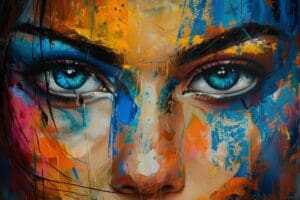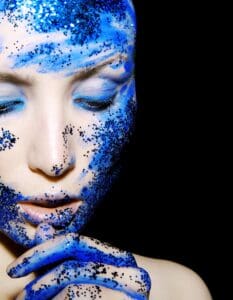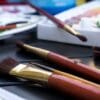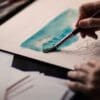Several people have accessed my web site over the last few years as a result of doing web searches on painting in gouache (pronounced “gwosh”, or “goo-wash”), probably lead there by the numerous gouache paintings listed on the site. There is some conflicting information published on this topic. Consequently, this article is to help you better understand this opaque watercolor medium based on over thirty-five years of experience in using it and as a professional art educator.
Purportedly, the ancient Egyptians first employed this paint and its use was later refined by the Italians, where we get the word originating as aguazzo, or guazzo. This is said to refer to “mud”, or “watercolor paint, splash”. It is some times used interchangeably as bodycolor and designer’s colors. Guazzo also supposedly was an idiom to describe the 16th Century technique of applying oils over tempera paint. None-the-less, gouache paints were exploited by illuminated manuscript artists and was later popular with some European decorative, as well as, landscape and nature artists, such as Albrecht Durer. Because opaque paints dry fast and can be applied with a flat, even tone, during the nineteen hundreds gouache was often the favorite of architectural and advertising illustrators; hence the paint got its moniker “designer’s colors.”
A gouache paint body is composed of several elements, including pigment and an opacity agent. These density additives differ depending on the manufacturer. Some contain blanc fixe (French for permanent white); in this case its barium sulfate (also used as a filler in papers). Other makers incorporate calcium carbonate, more commonly known as chalk, or a “precipitated” (technical for synthetic) chalk. When the water container for rinsing brushes in during this painting process is emptied, one can see the thickening material as sludge on the bottom of the container. Gum arabic is the binding agent all gouache paint makers embrace to coalesce the ingredients. In some cases glycerin and preservatives are also mixed in. The principle differences between transparent watercolors and opaque is the addition of a chalky substance and the amount of gum arabic; gouache contains a higher concentration of the latter. When gouache is applied as an impasto, it’s the gum arabic that can give the dried painting a pearly patina. If used too thick, as with tempera, the paint will crack. Normally, a gouache painting will have a dull surface appearance. This makes it ideal for photographic reproductive purposes and is another reason why it has been popular with illustrators.
A few sources I’ve read say that gouache comes only in tubes. That is not so. I’ve got a Pelikan brand pan set that I acquired in my teens when I first started using this type of paint in the mid 1970’s. These pans, called a “cake” form, have the advantage of being able to acquire replaceable color cakes and a built in palette. Because gouache paints can be rewet and worked when dry, as cakes become empty you can squeeze tube paints into the cake receptacles. Tubes of gouache are said to have a shelf life of 3 to 5 years, that’s when the tubes solidify. When this occurs I break open the tubes and use the dried form just as I do the cake variety. Sometimes I will use a single edge razor blade to shave off needed amounts into a palette. Apparently gouache also can be purchased as a liquid, but only in small jars of black or white. These are probably the only two available because they are the two colors used in largest quantities and the heavy opacity content causes settling in the jars.
A few advantages and uses of gouache have already been addressed, yet there are more. Because gouache painting materials are easily transportable and dry fast, as with transparent colors, they are ideal for plein air (painting outdoors) pieces and some artists have used gouache as preliminary sketches for larger oils. As stated earlier gouache can be rewet after it dries, so, plein air paintings can be reworked back in the studio. This quality also allows colors to be gradually blended and mixed on the painting’s surface. Furthermore, gouache works fine on tinted papers and may also serve as an underpainting for pastels.
The transparent watercolor techniques of wet-on-wet, dry brush and spattering can also be accomplished with gouache. However, due to the opacity material paints do not bleed, or blossom, as much in wet-on-wet as transparent colors. Liquid masking agents may also be used for blocking out areas to leave white, though most gouache artists just take advantage of white paint. As you may know, “glazing” in painting is the process of painting a thin, diluted layer of color over another. Once again, because of the chalky substance in gouache, many believe you cannot use glazing with gouache. However, to solve the problem of the base paint mixing with the diluted paint as the glaze is brushed on. I spray a single layer of fixative (the same stuff used on pencils, chalk, and pastels to keep them from smearing) over the work and let it dry. Then I glaze over an area, particularly for shadows. There are two concerns in doing this. First of all the fixative cannot be too thick or else the paint you put over the top will bead up and not cover. The second also must be kept in mind and planned for. It can change the color, especially washing out thin layers of white areas. I will address this again when I talk about finishing paintings. Additionally, I’ve also satisfactorily used gouache for air brushing, as in the paintings “Family Outing” and “Morning Stretch”.
The ability to be mixed with other water base paints is another admirable characteristic of gouache, especially with transparent watercolors. It’s been said that gouache does not mix well with acrylics because the paint will glob up, think of it as curdling, as cottage cheese. I have never had this problem, but then I don’t use a lot of gouache from tubes added directly with acrylic paint, only small amounts. The way I mix them works quite well. However, since acrylic dries as plastic with a slick surface, in order to paint gouache over acrylics, a thin layer of fixative needs to be applied to let the gouache bind.
Any watercolor papers used for transparent watercolor painting may be used with gouache. Hot pressed, or smooth toothed papers of 140 pounds or thicker work well. I prefer to use mounted rag paper called watercolor board made by Crescent. Another paper I’ve had success with is a four ply rag paper used in museum mounting. This paper I wet and then stretch over a wooden frame made of one by two’s. The softened cotton paper is then stretched and stapled just as you would canvas.
When it comes to finishing and displaying gouache paintings there are numerous issues to consider. The most common way to approach framing gouache is to handle the same as you do transparent watercolors, matted and framed under glass. In the mid 1980’s I stopped using this method for three reasons. A gouache painting, “Misty Warm December”, I had entered in a National Wildlife Art Collector’s Society exhibit in Minneapolis, Minnesota was disqualified from competition by the judges because they thought the original was a print, no brush strokes were apparent on the surface of the paper, it had an even, flat surface appearance and was under a white mat.
The second reason has two inherent issues that arise with shipping paintings under glass. One is increased expense of transportation due to weight compared to paintings not under glass and the other is breakage. To address these problems I took a look at how acrylics were handled. Gouache paintings can be finished with any acrylic varnish medium; however, a few layers of fixative must be sprayed on so the paint is not smeared by the acrylic varnish. This will eliminate the dull, chalky appearance of gouache and the pieces will look like oils. These pictures I then put directly into frames without glass. For some reason, I’ve noticed that pictures with a high gloss varnish tend to sell faster than others.
The third reason I prefer to acrylic varnish over gouache is the richness and depth it brings to the color qualities of the finished product. This obviously means that the colors will change somewhat. Consequently, you need to practice with this technique several times to be familiar with how it affects paints. When it comes to creating the illusion of water and make it truly feel wet, there is no other type of paint I’ve worked with that will do the same job. Since whites tend to wash out, to get strong whites and other bright colors I mix in acrylics.
As with any watercolor, transparent or opaque, no matter how the work is framed when it comes to displaying them make sure that they are out of direct sunlight and are not under long term exposure in fluorescent lights, as these give off a low level UV radiation that will eventually fade the colors, unless they are under UV protective glass.
Hopefully, you’ve gained some insight into this versatile medium of gouache and are not afraid to try it yourself. If you have any questions, please feel free to contact me.





